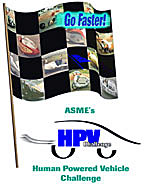AMES, Iowa -- It's lighter than last year's winning vehicle. Closer to the ground. A little smaller. There are even small shock absorbers to take some vibration out of the pedal-powered ride.
But will it be another winner?
Iowa State University's Human Powered Vehicle Team is about to find out.
Ten of the team's 15 active members are heading to Philadelphia and Drexel University for the April 17-19 Human Powered Vehicle Challenge -- East. The competition is sponsored by ASME, founded in 1880 as the American Society of Mechanical Engineers. Teams from 27 colleges and universities are expected at the competition. Iowa State's team will try to continue an Iowa State tradition of winning a few trophies.
"When it all comes together, I think we'll have a competitive vehicle," said Zach Reinhart, a team leader who's a graduating senior from Cedar Rapids and a mechanical engineering major. "It will be lighter and smaller than anything we've built. And that should make it faster."
Last year's Iowa State vehicle took first place overall in the multi-rider event during a competition at the University of Wisconsin-Madison. The vehicle also won awards for multi-rider design, multi-rider sprint, utility contest (which simulates the stops, starts, turns and carrying capacity required to run an errand) and utility design.
But this year's $3,000 vehicle was still a work-in-progress earlier this week. The drivetrain for the two-person, three-wheeled machine needed to be installed. The two back-to-back seats needed to be mounted. An aerodynamic fairing needed to be built. And Kris Cory, a senior from Quincy, Ill., who's majoring in electrical engineering, was in the shop attaching headlight mounts to the steel frame he helped weld together.
Reinhart smiled. Yes, he said. There would be some long nights in the team's campus shop.
But he was upbeat the team's chances and its future.
These, after all, are days when there's lots of talk about energy efficiency and reducing carbon footprints.
So, he said, it has been a little easier to recruit new team members willing to stay up late to build a lighter, smaller and faster human-powered vehicle.
